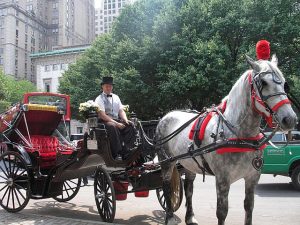Rather than fight totally for one side or the other on this issue, as personal opinions will generally differ, I would support continued horse riding in the city, specifically in Central Park, so long as conditions are comfortable, humane and safe for horses. Several years ago I worked with a NYC resident, an equestrian and others who wanted to bring trail riding and public horse stables back to Central Park. From 2007 through 2011, trail riding was provided by the Riverdale Equestrian Center but this offering has since ended with no indication of when or if it will recommence. The Claremont Riding Academy, located at 175 W. 89th Street, operated for a number of years but closed because of limited funding and declining support from patrons and city government.
I think the park should designate an area, preferably an existing building, as a hub for equestrian riding in NYC. I have looked at several existing historic structures in the park and found one that would allow for this idea to be accomplished. However, the “powers that be” saw it differently and found other uses for that structure which in my opinion would have made a perfect historic stable for both trail riding horses as well as carriage horses.

Therefore, in summary my resolution to the issue is to “make lemonade from lemons”:
- Take the horse drawn carriages off the public streets;
- Continue horse drawn carriage rides inside Central Park;
- Provide decent, healthy, safe, regulated stabling that is either inside the park (preferable) or very close by;
- Regulate the handling of the horses so they have the proper stabling, exercise, feeding, and care to address their other needs such as vet and farrier;
- I do not know how many carriages there are and how often they are used but it appears to me there are more than is necessary (if one judges by the number waiting and literally standing on the on the street). If that is the case, regulations should license and restrict the number so they are not left standing, harnessed for hours on hours. Harnessing a horse and requiring that they remain that way for long hours strips the animal of control and can cause stress, fear, anxiety, etc. And yes, horses really do have these feelings and it is inhumane to not recognize and respond to those needs.
As mentioned above, I worked on a project pro bono several years ago to bring horseback riding with permanent stabling inside Central Park. It went nowhere. I was especially disappointed that it was unsuccessful because the mayor at that time, Michael Bloomberg, has an unusually strong connection to the equine community and could have, in my opinion, done something to make it happen. Perhaps he was unaware of the project or maybe he was opposed to it. I don’t know. There were and still are a number of people, historical groups, environmental groups, parks and recreation departments who have their own concerns and agenda for Central Park. It is such an amazing space and I do not disagree that it needs to be protected and preserved, but horses in NYC and in Central Park are also historic. Merging these two legacies without sacrificing the authenticity of either is surely not impossible.
I think both sides, and most importantly the horses, can come out a winner on this. The health and safety of the horse must be our priority but that does not mean the other concerns cannot be addressed and served in some capacity. I would like to help. Please provide your comments and thoughts. I must be honest: if they are political in nature I am not that interested. I am interested in the humane treatment of horses and their inclusion within our society. They are, next to dogs in my opinion, man’s best friends.
Want to go back to Part 1 of this article? Click here.